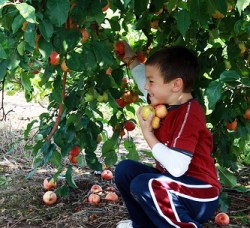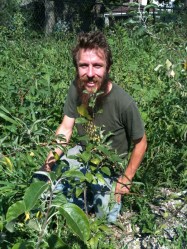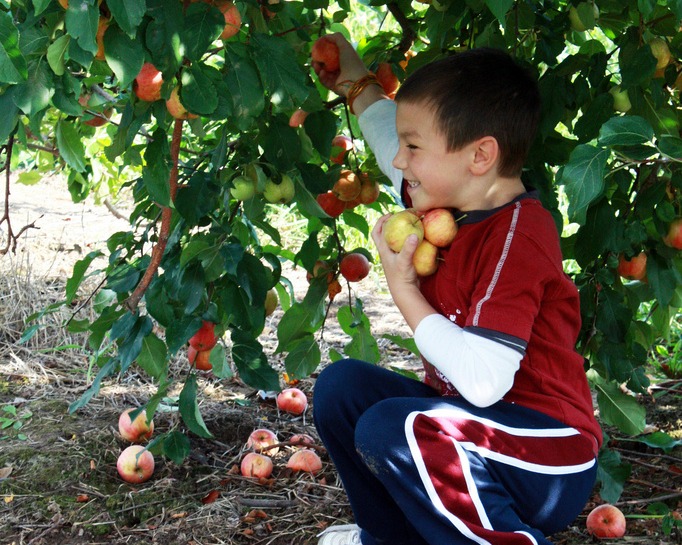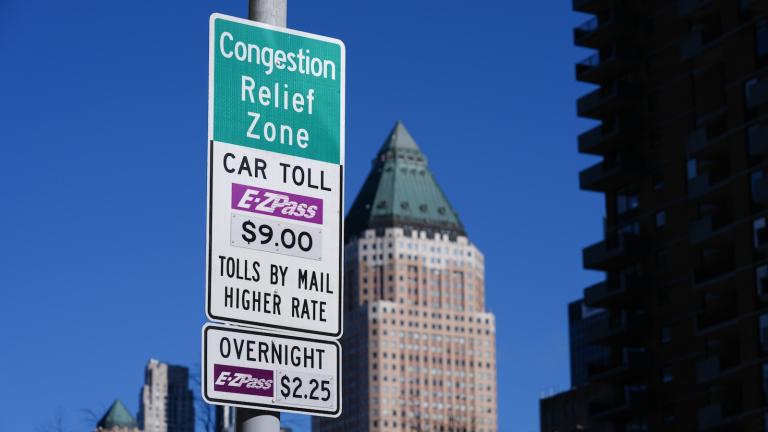
Photo by Sarah Hicks.
Chicagoans will crave the Spitzenberg apple, Dave Snyder is certain. Whether in hand or in a morning danish, the name will simply roll off their tongues.
Snyder is an urban farmer and founder of the Chicago Rarities Orchard Project, or CROP. Inspired by author Michael Pollan’s Botany of Desire and North Carolina rare-apples grower Creighton Lee Calhoun, Jr., Snyder thought his diverse and congested Logan Square neighborhood a befitting home for the city’s first orchard, where rare varieties of apples, such as the Spitzenberg, dangle from branches.
The image wouldn’t leave him alone. “I kept seeing all of these abandoned and open spaces and dreamed up this idea,” says Snyder. Determined, the former Seattle resident sporting a Rip Van Winkle-ish beard met with city officials on a quest to find some land.
And find land he did. The city offered CROP land as part of something called the Logan Square Open Space Project [PDF], which transferred the land to NeighborSpace, a nonprofit land trust. City taxes will pay for infrastructure and build-out of the orchard, says Peter Strazzabosco, spokesperson for the Department of Zoning and Land Use Planning, adding that the orchard “is the first of its type for Chicago.” All of the plantings and manpower, Snyder says, will come from CROP.

Orchardist and CROP mastermind Dave Snyder.
The last tweaks to the plan have been finalized by the city, and ground breaking will begin in early 2013. And when completed, what was once a derelict, potholed, and trash-strewn pie-shaped swath of land will transform into one of the first urban orchards dedicated to juicy fruits from long ago.
Along with 70 apple, peach, and cherry trees, as well as vine and shrub berries, Chicago’s Logan Square orchard will be a public plaza with seating and walking paths, finally bringing some green space to a neighborhood once known for its lush boulevards. A city location in every way, replete with porch sitters and food vendor carts, elevated train tracks will amble alongside and above the orchard, making the contrast a far cry from the days when our forefathers grew many of the same varieties.
More than 50 of the trees — funded by the sale of a potent seasonal fruit cocktail sold in the Chicago restaurant where Snyder tends a rooftop garden — have been grafted and are temporarily growing in an abandoned lot owned by a Chicago fireman. The apple varieties alone include: the weeping Limber Twig, the Jefferson, the Blue Pearmain, the Dolgo Crab, the American Beauty, and the Black Ben Davis. When mature, at about 6 feet, the trees, says Snyder, himself about 5-foot-5, “will be the right size for easy pickin’.”
Urban orchards, often considered the second wave of urban agriculture, are becoming a metropolitan staple. Philly boasts the Philadelphia Orchard Project; then there’s the Boston Tree Party, San Francisco’s Urban Orchard Project, Austin’s TreeFolks, City Fruit in Seattle, and across the pond, The London Orchard Project.
What’s different about the CROP site is the focus on rare varieties that have all but disappeared. Industrialized farming created a decline in small farms, where most of the heirloom varieties grew to serve local communities. Meanwhile, a handful of hardy, easy-to-ship varieties have essentially taken over the industry.
Planting and eating these varieties is an important way to bring them back. Consider, Snyder says, “that in the last 100 years, at least 90 percent of apple varieties have vanished worldwide. Too few varieties is what caused the Irish Potato famine as well as the Wheat Rust plague that reemerged in Uganda in 1999.”
Some local residents were not readily swayed. Upon hearing that the parcel would become an orchard ripe with paw paws instead of a bar, some residents wondered “what the f—‘s a paw paw?” A hotdog stand, wine bar, and parking lot were all tossed out as alternatives. But paw paws?
Snyder’s retort: “They’re juicy, Midwestern, and were a favorite of Thomas Jefferson! Wait until they taste them!” The wait, though, could be three to 10 years before the trees are fully mature. Plans are then to divide the bounty with homeless shelters and community centers and sell to local chefs.
“We want to make certain that the fruits have some value and chefs put them on their menus,” says Snyder. “I can see it. The waiter walks to the table and says ‘Hello! For dessert we have apple crisp made with an Esopus Spitzenburg apple that’s grown right across the street.’”
Already in discussions with the city for future locations, CROP sees potential in Chicago’s Garfield Park, Lawndale, and Austin neighborhoods as well. Snyder is also searching for land for a rare-fruits nursery where young trees can be nurtured before being transferred to the orchard. He dreams that other cities will start their own rare-varieties orchards, making the names of those long-lost apples, peaches, pears, cherries, and paw paws as familiar as, say, the Granny Smith.



